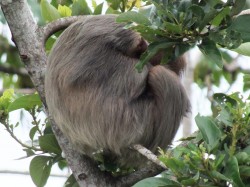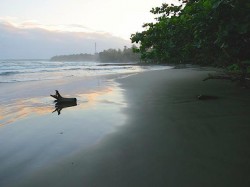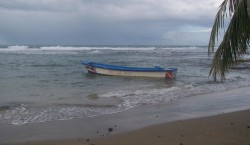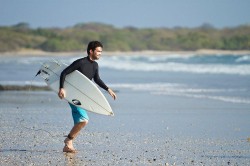
The Caribbean coast of Costa Rica is 134 miles long from its border with Nicaragua down to Panama.
This so-called ‘Amazonia’ is composed of canals and turtle nesting sites that include such towns as Tortuguero, down to the once thriving post of Limon and further to the palm-lined beaches and coral reefs of the south Caribbean, where its laid-back towns of Cahuita, Puerto Viejo and Manzanillo invite many.
These areas attract tourists eager to experience its wildlife, beaches, National Parks, surfing and Caribbean food and culture.
The Caribbean coast has a multicultural atmosphere that is unique to Costa Rica. The Spanish first landed in Limon but chose to establish their cities and rule from the relative cool of the Central Valley, leaving the jungle-tangled coastline and wild mountains to the indigenous population which remain strong to this day. Conversely, the other natives across this country fell to diseases and cruelty. Turtle hunters from the Caribbean islands were seasonal visitors to the coastland and gradually settled; moving families across the sea to what had been temporary shelters to build small communities which retained contact with the islands rather than with the rest of Costa Rica during the eighteenth century. More Afro–Caribbean migrants came to build Minor Keith`s railway to link the flourishing banana plantations and stayed in Limon or in communities that emerged along the railroad. Laws restricted the movements of the black population to other parts of Costa Rica until 1948 and made it difficult for the Afro-Caribbean people to obtain citizenship. The advantage of this racism was that the culture, traditions and language of the Caribbean inhabitants remained strong and can be heard in the voices and music, tasted in the spicy dishes and seen in the faces of the people to this day. Chinese immigrants have been here running small businesses for generations and their culture is proudly celebrated in the Carnivals with dragons dancing alongside Caribbean carnival queens. In the last half of the twentieth century, European and North American surfers, backpackers and hippies discovered the delights of this laid-back paradise and settled here too; bringing their languages and cultures to the area.
The climate on the Caribbean coast is not the same as the rest of the country. Generally the seasons appear reversed — when the Caribbean is at its best with calm waves and hot, sunny days through September and October; Costa Rica is officially in the height of rainy season. Annual rainfall averages 134 inches and the temperature is around 80° F, so humidity is high and the sun’s hot! When it rains on the Caribbean, it rains hard, but fortunately a huge overnight downpour can often be followed by a day of blistering sunshine.
Leave San Jose on Route 32 which winds through the Braulio Carrillo National Park with breathtaking views over the miles of forest-covered mountains and waterfalls that cascade over the ferns and umbrella plants at the side of the road. The route continues at sea level once the mountains have been cleared and through pastures with cattle and pineapple and banana plantations until reaching Limon. For the southern Caribbean, take Route 36 which is signposted on the right side of the road as it enters Limon City. Follow Route 36 along the coastline to your final destination. Some bridges are one-lane only — with the right of way given to traffic heading towards Limon.
From renting a hammock by the night to luxury accommodation suites to vacation rentals, the Caribbean can offer a range of accommodation but tends towards boutique hotels rather than large, all-inclusive resorts.
The typical Costa Rican fare is available, but most visitors to this region are tempted by the Jamaican influenced cooking style with coconut milk and spices livening up the rice, beans and seafood that is available. Foreign residents have brought their dishes with them and restaurants can be found serving anything from sushi to pizza.
This coast has long had an unfair reputation for violence and crime. Certainly, the city of Limon has its problems — as do many ports worldwide, but the rest of coast generally has little more in the way of crime than petty theft. Common sense is the key to protecting your personal possessions. Don’t carry large sums of cash on your person or wear expensive jewelery. Keep your bag with your camera where you can see it, even if you are swimming in the ocean a white-faced monkey or raccoon is more likely to rummage through your backpack than any thief!

"Mother & Baby" photo © Sara Ford
Despite being inaccessible by road, Tortuguero’s National Park is the third most visited in the country. Visitors can either take a short flight from San Jose or drive to Moin or Cariari where a boat trip through the canals brings the traveler to the small town of Tortuguero. From Cariari, La Pavona the boat trip is 1 to 2 hours, depending on the water level, and costs only a few dollars. From Moin (just outside Limon) the boat trip is about 4 hours and so it’s pricier; around $70 for a round trip. Boats leave from Moin at 10:00a.m. daily. Nature Air flies daily, or more frequently in peak season, with ticket prices between $90 and $130 for a thirty-minute flight from San Jose.
Originally a fishing settlement, the village now caters for fairly upscale guests with lodges complete with swimming pools removed from the main town or more budget accommodation in guesthouses within the village itself.
The main appeal of Tortuguero is the turtles that give the place its name. Once the population made their living from hunting these reptiles, but now the town’s tourism industry thrives on their preservation as vacationers head out on night tours to see the turtles lay their eggs and watch the hatchlings dig their way out of the sandy nest to struggle down to the ocean. This isolated area is also one of the few places left in the country where jaguars roam freely, ironically to feast upon the equally protected turtles and their eggs! A guided boat/canoe tour through the park’s canals will reveal an incredible array of birdlife and inevitably crocodiles and caiman that slip off the muddy shores to slowly meander through the chocolate-colored waters.
The faded colonial city of Limon has been given a facelift in recent years to restore some of its buildings to their former glory, but the city retains its poor reputation for security due to its dubious position as a stopover point on the Columbia-U.S.A. drug route. Generally, the city is not a risky place to visit during the day though.
The most photographed site is probably the Liberty Hall, better known as the Black Star Line, which was built under the leadership of black activist Marcus Garvey.The restaurant on the ground floor serves great local dishes. Other buildings that show the port`s former importance as a thriving center for trade are its Post Office — with high ceilings and painted panels depicting the history of Limon and the Bapist church. There are still sloths to be found in the Parque Vargas at the ocean front where the well-to-do and prosperous citizens of a century ago used to stroll in the evening.

"Sleeping Sloth" photo © Sara Ford
October is the month of Carnival when the whole city comes alive in color and music with parades, marching bands and scantily-clad dancers on floats pass through the center and the partying lasts more than a week! Limon has its beaches, but those further south tend to be cleaner and less crowded than those on the outskirts of town. There are waves to be found for those traveling with boards, but water quality can be questionable, even if the brave might be tempted by the waves at Isla Uvita off the shores of Limon.
The southern Caribbean beaches remain relatively untouched compared to many of the more developed beach resorts on the Pacific Coast since it took a relatively long amount of time to establish the basic infrastructure in order to link it to the rest of the country. Neither electric lines nor a paved road were completed until the 1980s, leaving this part of the country very difficult to get to for even adventurous tourists.
Swiss travelers settled in Cahuita about thirty years ago, drawn to the Switzerland of Central America where they were joined by Italians, Spanish, French, German and Canadians. This latest wave of immigrants to the coast adds to its color, languages and multiculturalism.
Cahuita’s main tourist attraction is its national park where well-kept trails allow the visitor to walk through a jungle filled with monkeys, sloths and a myriad of butterflies with the white sand beach and often crystal clear ocean running alongside. The park is unique to Costa Rica in that the entry fee at the Cahuita entrance is donation based.
The coral reefs are best explored with a guide and a boat to be taken out to the best spots to see clown fish and nurse sharks amongst other marine life. Surfers gather at the park entrance for the reef break when “surfs up”. Those in the know drive around to the national park’s Puerto Vargas entrance where the waves are usually larger than elsewhere — although the reef can be dangerous.
The Black Beach is made up of glistening volcanic sand and can be a great swimming spot, but watch out for riptides when the waves are strong. When the waves are high, surfers will find the beach break a thrill although the waves are not generally that big. The Reggae Bar in front of the beach offers a great view and local dishes washed down with cold beer. More expensive accommodation is found on the Black Beach, out of the hustle and bustle of the town’s center.

"Secluded Black Beach" photo © Sara Ford
Much further along the same road, but away from town is Playa Grande, an almost deserted beach that leads up to Tuba Creek.
The town center has all the basic facilities such as a bank, ATM and pharmacy; a couple of bars, Coco’s and Ricky’s, with live music nights and cold beer and restaurants serving local and foreign dishes. Miss Edith’s is probably the best-known restaurant for local dishes such as Jerk chicken. Try Kawe Soda for breakfast or lunch with the traditional taste of wood stove cooking for a hearty, local meal. The Swedish bakery is a popular breakfast choice for good coffee and freshly baked breads. Pizza and pasta fare is readily available.
Three local supermarkets sell local and foreign products at inflated prices, a farmers’ market is held on Sundays with local fruit, vegetables and dairy products and Pali (Wal-Mart owned) supermarket offers cheap and basic goods fifteen minutes drive towards Puerto Viejo. Fresh fish can be bought from local fishermen at around 10:30am to 11:00am as they return from the ocean with mackerel, kingfish and snapper. Stores within the unattractive White Sands Mall stock fresh fruit and vegetables and there is a butcher too. A number of stores offer souvenirs and postcards.
Activities to enjoy in Cahuita are hiking in the park, snorkeling, fishing, yoga, and horseback riding along the beach and through the jungle. These can be booked through Willie’s Tours. The Sloth Sanctuary is about a ten minute drive back towards Limon from Cahuita and has slowly grown from the Costa Rican/U.S. owners taking in an injured sloth to a huge reserve with a large number of injured and abandoned baby sloths housed in the property which also offers a river boat ride as part of its tour.
Up until very recently, Puerto Viejo or Old Harbor was overshadowed by Cahuita, but the town has exploded into a surf and party Mecca — listed as one of Costa Rica’s five ‘must sees’ by the Lonely Planet Guide. The town itself is geared towards a lower budget with more luxurious accommodation options to be found on the road heading out of town towards Manzanillo.

"Just Like That" photo © Sara Ford
The Black Beach with its volcanic sand runs alongside the road into town with its landmark — a beached barge — which local children use to jump off into the waves and which can provide waves for beginner surfers. White sand beaches edge the town’s center and the bars and restaurants tumble onto them.
Leaving town, the surfer’s dream and nightmare rolled into one is the thrilling Salsa Brava, fierce waves over reef. This is the Caribbean surf high spot with barrels between January and March. Unsurprisingly, competition for the best waves is strong when the surf’s good.
Surf boards can be rented and locals will happily give paid lessons to newcomers. Diving or snorkeling boat trips are popular activities for a morning or afternoon. Reef Runners is the PADI certified dive center in town. Horseback riding, ATV tours, kayaking and ziplining are also available too.
Puerto Viejo has a range of eateries from delicious morning chocolate croissants at the beachside Pan Pay to vegan specialties at Veronica’s Place and pizza at Café Viejo. Local food can be found in tiny home-based sodas, like Miss Sam’s.
Top-end clothing and furniture stores in the seemingly out of place, but pretty stylish mall, ply for trade against the tiny roadside stores and market stalls where customers can purchase all things imaginable in Rasta colors and with marijuana leaves.
The town boasts two pharmacies, two banks and a number of small supermarkets, including MegaSuper. Butchers, fishmongers and a farmers’ market on Saturdays mean that fresh local produce is easily available.
Spa treatments, massage and beauty salons are fairly abundant to pamper and indulge the visitor on vacation. Yoga classes are widely available.
Nightlife revolves around a number of bars and discos – Jhonny’s and Stanfords are the usual hangouts for locals, ex-pats and tourists alike to party into the early hours.
Just outside of Puerto Viejo lies the white sand surf beach of Playa Cocoles. The beach’s strong currents have led to local businesses funding a life guard, but the riptides don’t stop the surfers coming for the waves which are better at high tide.

"Racing for the Waves" photo © Sara Ford
Seafront accommodation and restaurants make this little spot a popular alternative base to the busier town of Puerto Viejo.
This part of the coast and down towards Manzanillo has a number of more exclusive hotels, not all-inclusive, but high quality establishments where guests can stay without having to leave the property with restaurants and beach access provided, like La Cameleon.
This bay is overlooked by sea grape trees which give the beach its name. The water is deep, but usually calm.
Some restaurants and hotels have been built along the road through the area, but it remains relatively undeveloped. Selvin’s is locally run and serves food so good that city dwellers from Limon drive down to taste it.
Korrigan Lodge is the Trip Advisor’s number one recommendation for this stretch of the coast with comfortable bungalows set in the jungle.
This part of the coast and down towards Manzanillo has a number of more exclusive hotels, again, not the all-inclusive types, but where one can enjoy their entire stay within the property if they so choose.
The palm tree lined, white sand beach has coral rock pools and shallow swimming access. The pretty beach is quiet and a place to get away from the crowds.
The Jaguar Rescue Center is located just off the main road and offers guided tours twice daily at 9:30am or 11:30am only. The rehabilitation center takes in any animal that has been mistreated or injured with an aim to releasing back into the wild once it has recovered.
The sleepy fishing town of Manzanillo is at the end of the bumpy, but at least now paved (since 2003) road from Puerto Viejo and is a favorite spot for tourists and locals alike. The pretty beach is usually good for swimming and there are a number of stunted almond trees to provide shade.
Walk along the beach and across the river to enter the Gandoca-Manzanillo Wildlife Reserve — a stretch of coastline that rises and falls with small cliffs and tiny secluded beaches. The first cliff top has a small gravestone to mark the tomb of one of the area’s first inhabitants. The more adventurous can hike through to Monkey Point, which is an organic farm open to visitors and even onto Gandoca with its swampy lagoon and nesting beaches for a number of turtle species.
During turtle season the beach here isn’t accessible without a guide and generally the beach at Gandoca is unsafe for swimming as riptides and sharks — that are drawn by the promise of fresh, turtle meat. The turtle season lasts from March to July; with the peak of the egg-laying occurring in April.
Night tours can be booked either directly with the ANAI Association, who organizes the annual protection program along the beach to prevent the poaching of egg, or with a tour company from Cahuita or Puerto Viejo, which will include transportation. The tours can be uncomfortable as waiting in the dark on a beach infested with sand flies isn’t really anyone’s idea of a dream vacation, but to see a Leatherback turtle emerge from the waves and pull herself up clumsily and awkwardly across the sand to dig her nest, lay her eggs and slowly return to the ocean, is a sight worth enduring!
The well-known Maxi’s Restaurant in Manzanillo offers traditional rice, beans and fish with a view over the waves and golden sands. Other small sodas (restaurants) have similar menus at cheaper prices, just follow the crowd.
Accommodation is available, but many tourists prefer to stay further up the coast and visit the town as a day trip. The bus service is fairly infrequent to this little corner of the Caribbean, so it’s far more convenient to drive yourself there.
Snorkeling is popular here when the ocean is calm and diving can be organized too.
Named for the indigenous inhabitants of the region, Bri Bri is the county capital of Talamanca, the southern Caribbean county. It is a jumble of official building and unattractive stores, but is the gateway to the local traditional culture. Tours can be taken through the Bri Bri villages to see traditional housing with either the thatched roofs over communal huts or the more modern style of multicolored, painted wooden buildings; traditional wooden craft work and herbal medicines.
Perhaps the most popular of the indigenous tours is to see the chocolate production process from the cocoa pod to the dark bitter chocolate itself as first tasted by the Mayans thousands of years ago. People here have been harvesting and producing cocoa for generations. Now there once cottage industry is becoming big business as the world’s chocolate producers search for high quality organic cocoa.
A trip to the local waterfalls — where you can plunge into icy pools as the water thunders down through the rocks above — is the perfect end to a tour around the area.
And so, it isn`t difficult to see how tourists find themselves spending a lot of time on this side of the county. It is the perfect place to enjoy Costa Rica`s Green Season without lots of rain and to find a unique cultural experience with Spanish, Bri Bri and Limon English all filling the air with the blend of European and North American accents, the smells of ylang ylang, the ocean and rain-soaked earth, the bright feathers of the birdlife in flight and the taste of food cooked in coconut milk and Panamanian pepper. Find your corner of paradise and swing in a hammock to the sounds of the howler monkeys and toucans in the trees. Easily accessible and with all the comforts you`ll need for a relaxing vacation, the Caribbean coast is a perfect alternative Costa Rican vacation!